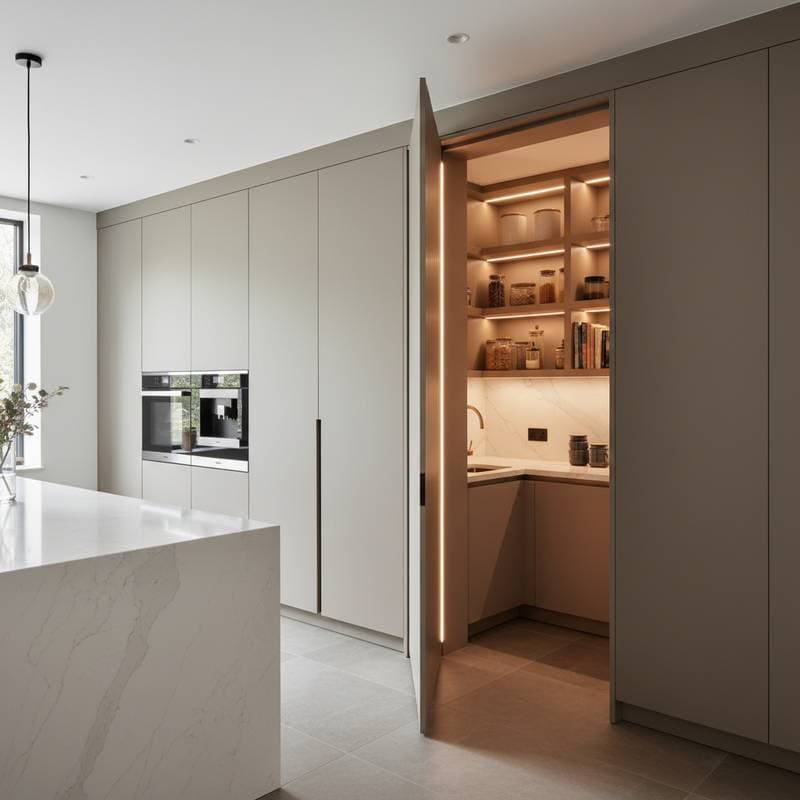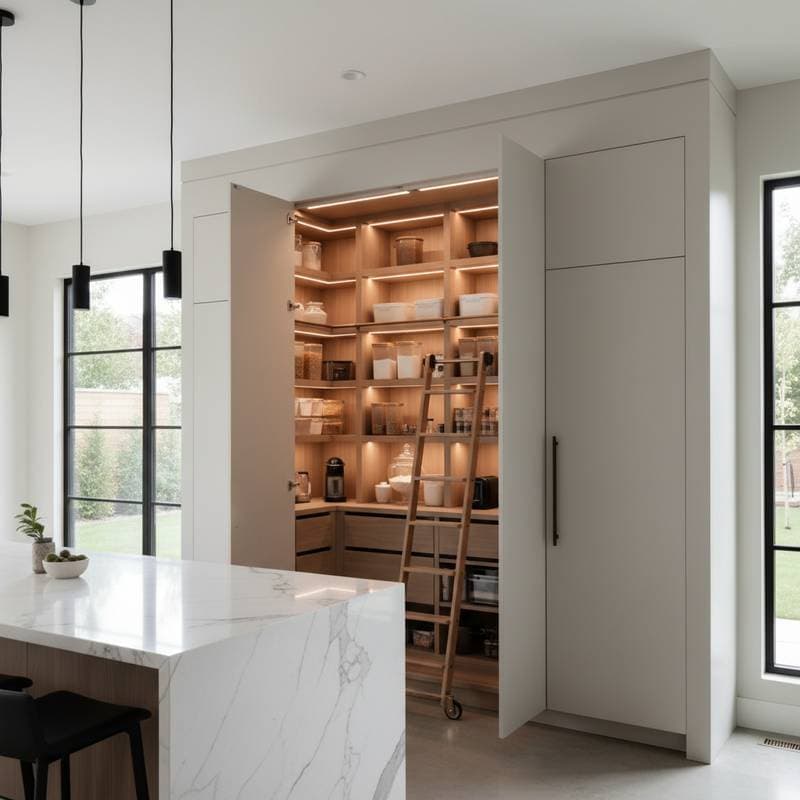The Value of Hidden Walk-In Pantries in Modern Homes
Homeowners seek features that blend functionality with aesthetic appeal, and a hidden walk-in pantry delivers both. This discreet storage solution organizes kitchen essentials without cluttering countertops or visible spaces, creating a serene cooking environment. Real estate experts note that such upgrades can increase a property's resale value by approximately 6 percent, as buyers appreciate the added convenience and sophisticated design.
The appeal lies in its seamless integration. Unlike traditional pantries with obvious doors, hidden versions use cabinet fronts or wall panels that match surrounding cabinetry, maintaining a clean lines throughout the kitchen. This not only enhances daily usability but also positions the home as a premium offering in competitive markets.
Understanding Cost Factors for Installation
Budgeting accurately requires breaking down expenses into key categories. Each element contributes to the overall investment, balancing quality with affordability.
Size and Layout Considerations
The dimensions of the pantry directly influence costs. A modest 4-by-6-foot space typically begins at $4,000, covering basic framing and shelving. Larger configurations, such as those exceeding 8 by 10 feet, often exceed $18,000 due to expanded materials and labor demands.
Hidden door installations demand precision. Custom carpentry for these features adds between $800 and $2,500, ensuring the door aligns perfectly with adjacent surfaces for an undetectable finish.
Materials and Finishing Options
Selecting appropriate materials sets the tone for durability and style. Paint-grade medium-density fiberboard (MDF) for shelving represents an economical choice, minimizing upfront expenses while providing sturdy support.
Upgrading to solid wood or bespoke cabinetry elevates the pantry's longevity and visual harmony. These premium selections increase costs by $1,500 to $4,000. Incorporating matching flooring and trim materials further refines the space, adding $500 to $1,200 to the total.
Lighting and Ventilation Essentials
Proper illumination and air circulation prevent common issues like dim corners or musty smells. LED strip lights or recessed fixtures provide efficient, even lighting for an additional $150 to $400.
Humidity control proves vital in enclosed areas. Installing a vent or compact fan maintains freshness, costing between $200 and $600, and safeguards stored goods from spoilage.
Labor, Permits, and Structural Needs
Professional labor rates range from $60 to $120 per hour for experienced carpenters. Structural modifications, particularly if involving load-bearing walls, necessitate reinforcements that add $1,000 to $3,000 and may require local permits for safety compliance.
Permits ensure adherence to building codes, avoiding future complications during resale inspections.
Mechanisms for Hidden Doors
The ingenuity of the hidden door defines the pantry's subtlety. Simple pivot hinges suit basic setups, while intricate sliding panels or camouflaged cabinet fronts command prices from $300 to $1,800 based on mechanical complexity and materials.
Advanced systems often include soft-close features, enhancing usability without compromising the concealed aesthetic.
Comparing DIY and Professional Installation
Deciding between self-installation and hiring experts depends on the project's scope and your skill level. Each path offers distinct advantages, but safety and quality remain paramount.
DIY Approach
DIY suits projects in existing framed closets or unused nooks, where minimal alterations occur. Essential tools include a circular saw, level, stud finder, drill, and finishing supplies to achieve professional results.
Limit efforts to non-structural changes, such as adding shelves or basic lighting. Safety precautions, like wearing glasses and gloves during cutting or sanding, protect against injuries and ensure clean execution.
This method empowers homeowners to personalize the space affordably, though it demands time and patience for flawless integration.
Professional Installation
Engage professionals for tasks involving wall modifications, electrical rerouting, or load-bearing adjustments. Their expertise guarantees code-compliant work and optimal ventilation.
Specialized carpenters excel in crafting hidden doors, delivering a polished outcome that maximizes value. While costs rise, the assurance of warranty-backed craftsmanship justifies the investment for complex builds.
Project Timeline and Cost-Saving Strategies
From initial design to final installation, anticipate 2 to 5 weeks, with custom elements like doors extending the schedule. Efficient planning minimizes disruptions to daily routines.
Order hardware in advance to sidestep supply delays. Sequence electrical installations before shelving assembly, and reserve painting for the end to preserve finishes.
Homeowners can reduce expenses by 10 to 15 percent through self-managed tasks, such as installing light fixtures or applying paint. These steps maintain control over the budget without sacrificing quality.
Long-Term Maintenance for Lasting Performance
Sustaining the pantry's condition extends its lifespan and preserves the home's enhanced value. Routine care focuses on environmental controls and mechanical upkeep.
Maintain indoor humidity below 50 percent to shield wooden components from warping. Quarterly vent cleaning prevents buildup that could lead to odors or mold.
Annual inspections of hinges and hardware identify wear early. Lubricate moving parts to eliminate noise, and verify warranty terms for hidden door systems, which typically span 5 to 10 years.
After any adjustments, apply touch-up paint to uphold the invisible seam, ensuring the feature remains a subtle asset.
Practical Steps to Plan Your Pantry Upgrade
Embark on this project with measured precision for optimal results.
-
Assess wall space adjacent to the kitchen, avoiding high-traffic cooking areas to preserve workflow.
-
Draft a detailed shelving plan, considering item heights and accessibility needs.
-
Solicit bids from at least two contractors, prioritizing those with concealed door expertise.
-
Allocate an additional 10 to 15 percent in your budget to accommodate unforeseen issues, especially in older properties.
-
Time the construction for moderate weather conditions, reducing humidity-related setbacks.
Realizing the Benefits of a Strategic Kitchen Investment
A hidden walk-in pantry transcends mere storage; it streamlines household operations and elevates property appeal. This upgrade quietly organizes chaos into efficiency, appealing to buyers who value thoughtful design. By investing thoughtfully, homeowners secure both immediate practicality and long-term financial returns.







